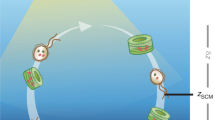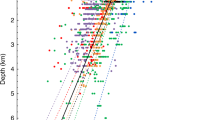Abstract
It is problematic that geochemical estimates of new production — that fraction of total primary production in surface waters fuelled by externally supplied nutrients — in oligotrophic waters of the open ocean surpass that which can be sustained by the traditionally accepted mechanisms of nutrient supply.1,2 In the case of the Sargasso Sea, for example, these mechanisms account for less than half of the annual nutrient requirement indicated by new production estimates based on three independent transient-tracer techniques2,3,4,5,6. Specifically, approximately one-quarter to one-third of the annual nutrient requirement can be supplied by entrainment into the mixed layer during wintertime convection7, with minor contributions from mixing in the thermocline8,9 and wind-driven transport10 (the potentially important role of nitrogen fixation11 — for which estimates vary by an order of magnitude in this region12 — is excluded from this budget). Here we present four lines of evidence — eddy-resolving model simulations, high-resolution observations from moored instrumentation, shipboard surveys and satellite data — which suggest that the vertical flux of nutrients induced by the dynamics of mesoscale eddies is sufficient to balance the nutrient budget in the Sargasso Sea.
This is a preview of subscription content, access via your institution
Access options
Subscribe to this journal
Receive 51 print issues and online access
$199.00 per year
only $3.90 per issue
Buy this article
- Purchase on Springer Link
- Instant access to full article PDF
Prices may be subject to local taxes which are calculated during checkout



Similar content being viewed by others
References
Schulenberger, E. & Reid, J. L. The Pacific shallow oxygen maximum, deep chlorophyll maximum, and primary productivity, reconsidered. Deep-Sea Res. A 28, 901–919 (1981).
Jenkins, W. J. & Goldman, J. C. Seasonal oxygen cycling and primary production in the Sargasso Sea. J.Mar. Res. 43, 465–491 (1985).
Spitzer, W. S. & Jenkins, W. J. Rates of vertical mixing, gas exchange and new production: estimates from seasonal gas cycles in the upper ocean near Bermuda. J. Mar. Res. 47, 169–196 (1989).
Sarmiento, J. L., Thiele, G., Key, R. M. & Moore, W. S. Oxygen and nitrate new production and remineralization in the North Atlantic subtropical gyre. J. Geophys. Res. 95, 18303–18315 (1993).
Jenkins, W. J. & Wallace, D. W. R. in Primary Productivity and Biogeochemical Cycles in the Sea(eds Falkowski, P. G. & Woodhead, A. D.) 299–316 (Plenum, New York, (1992)).
Jenkins, W. J. Nitrate flux into the euphotic zone near Bermuda. Nature 331, 521–523 (1988).
Michaels, A. F. et al. Seasonal patterns of ocean biogeochemistry at the U.S. JGOFS Bermuda Atlantic Time-series Study site. Deep-Sea Res. I 41, 1013–1038 (1994).
Lewis, M. R., Harrison, W. G., Oakely, N. S., Hebert, D. & Platt, T. Vertical nitrate fluxes in the oligotrophic ocean. Science 234, 870–873 (1986).
Ledwell, J. R., Watson, A. J. & Law, C. S. Evidence for slow mixing across the pycnocline from an open-ocean tracer-release experiment. Nature 364, 701–703 (1993).
Williams, R. G. & Follows, M. J. The Ekman transfer of nutrients and maintenance of new production over the North Atlantic. Deep-Sea Res. I 45, 461–489 (1998).
Karl, D. et al. The role of nitrogen fixation in biogeochemical cycling in the subtropical North Pacific Ocean. Nature 388, 533–538 (1997).
Michaels, A. F. et al. Inputs, losses and transformations of nitrogen and phosphorus in the pelagic North Atlantic Ocean. Biogeochemistry 35, 181–226 (1996).
Woods, J. D. in Toward a Theory on Biological-Physical Interactions in the World Ocean(ed. Rothschild, B. J.) (Reidel, Dordrecht, (1988).
Falkowski, P. G., Ziemann, D., Kolber, Z. & Bienfang, P. K. Role of eddy pumping in enhancing primary production in the ocean. Nature 353, 55–58 (1991).
Jenkins, W. J. The use of anthropogenic tritium and helium-3 to study subtropical gyre ventilation and circulation. Phil. Trans. R. Soc. Lond. A 325, 43–61 (1988).
Franks, P. J. S., Wroblewski, J. S. & Flierl, G. R. Prediction of phytoplankton growth in response to the frictional decay of a warm-core ring. J. Geophys. Res. 91, 7603–7610 (1986).
Strass, V. H. Chlorophyll patchiness caused by mesoscale upwelling at fronts. Deep-Sea Res. 39, 75–96 (1992).
McGillicuddy, D. J., Robinson, A. R. & McCarthy, J. J. Coupled physical and biological modeling of the spring bloom in the North Atlantic: (ii) three dimensional bloom and post-bloom effects. Deep-Sea Res. I 42, 1359–1398 (1995)).
Robinson, A. R. et al. Mesoscale and upper ocean variabilities during the 1989 JGOFS bloom study. Deep-Sea Res. II 40, 9–35 (1993).
McGillicuddy, D. J. & Robinson, A. R. Eddy induced nutrient supply and new production in the Sargasso Sea. Deep-Sea Res. I 44, 1427–1449 (1997).
Robinson, A. R. On the theory of advective effects on biological dynamics in the sea. Proc. R. Soc. Lond. A 453, 1–30 (1997).
Goldman, J. C. Potential role of large oceanic diatoms in new primary production. Deep-Sea Res. I 40, 159–168 (1993).
Dickey, T. et al. Initial results from the Bermuda Testbed Mooring program. Deep-Sea Res. I 45, 771–794 (1998).
Jannasch, H. W., Johnson, K. S. & Sakamoto, C. M. Submersible osmotically pumped analyzers for continuous determination of nitrate in situ. Anal. Chem. 66, 3352–3361 (1994).
Richman, J. G., Wunsch, C. & Hogg, N. G. Space and time scales of mesoscale motion in the Western North Atlantic. Rev. Geophys. 15, 385–420 (1977).
Michaels, A. F., Bates, N. R., Buesseler, K. O., Carlson, C. A. & Knap, A. H. Carbon cycle imbalances in the Sargasso Sea. Nature 372, 537–540 (1994).
Jenkins, W. J. Studying subtropical thermocline ventilation and circulation using tritium and 3He. J.Geophys. Res.(submitted).
Lipschultz, F. & Owens, N. J. P. An assessment of nitrogen fixation as a source of nitrogen for the North Atlantic Ocean. Biogeochemistry 35, 261–274 (1996).
Acknowledgements
We thank W. Jenkins, J. Goldman, S. Emerson, P. Cornillon and J. Yoder for discussions; E. Fields for his contribution to the processing and analysis of the various data sets; and the BATS technicians for their assistance. This work was supported by JPL, NASA, the US NSF, NOAA and ONR.
Author information
Authors and Affiliations
Corresponding author
Rights and permissions
About this article
Cite this article
McGillicuddy, D., Robinson, A., Siegel, D. et al. Influence of mesoscale eddies on new production in the Sargasso Sea. Nature 394, 263–266 (1998). https://doi.org/10.1038/28367
Received:
Accepted:
Issue Date:
DOI: https://doi.org/10.1038/28367
This article is cited by
-
Cross-shore transport and eddies promote large scale response to urban eutrophication
Scientific Reports (2024)
-
Efficient biological carbon export to the mesopelagic ocean induced by submesoscale fronts
Nature Communications (2024)
-
Changes in nutrient stoichiometry in responding to diatom growth in cyclonic eddies
Geoscience Letters (2023)
-
The influence of marine protected areas on the patterns and processes in the life cycle of reef fishes
Reviews in Fish Biology and Fisheries (2023)
-
Effects of multiple dynamic processes on chlorophyll variation in the Luzon Strait in summer 2019 based on glider observation
Journal of Oceanology and Limnology (2023)
Comments
By submitting a comment you agree to abide by our Terms and Community Guidelines. If you find something abusive or that does not comply with our terms or guidelines please flag it as inappropriate.



